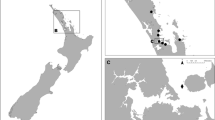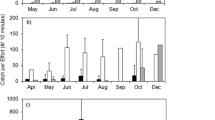Synopsis
Predation and contaminants are two possible factors in the poor recruitment of young lake charr Salvelinus namaycush in the Great Lakes. We measured the feeding rate of slimy sculpins Cottus cognatus and burbot Lota lota on young lake charr (uncontaminated young from eggs of a hatchery brood stock and contaminated young from eggs of Lake Michigan lake charr) in laboratory test chambers with a cobble substrate. The median daily consumption rate of sculpins for all tests was 2 lake charr eggs (N = 22 tests; 95% confidence interval, 0–13) and 2 lake charr free embryos (N = 31 tests; 95% confidence interval, 0–10). Feeding rate did not differ between hatchery and contaminated prey. Slimy sculpins continued to feed on lake charr when another prey organism, the deepwater amphipod Pontoporeia hoyi, was present. Feeding by burbot on free embryos (4–36 d−1) increased as the mobility of young increased, but burbot consumed about 10% of their body weight weekly in free-swimming young (140–380 d−1). Predation on lake charr eggs by sculpins could be considerable over the 100 to 140 d incubation period, and burbot could eat large numbers of free-swimming lake charr as the young fish left the reef. Predation pressure on young lake charr may inhibit rehabilitation of self-sustaining populations of lake charr on some reefs unless a critical egg density has been reached.
Similar content being viewed by others
References cited
Atchison, G.J., M.G. Henry & M.B. Sandheinrich. 1987. Effects of metals on fish behavior: a review. Env. Biol. Fish. 18: 11–25.
Bailey, M.M. 1972. Age, growth, reproduction, and food of the burbot, Lota lota (Linnaeus), in southwestern Lake Superior. Trans. Amer. Fish. Soc. 101: 667–674.
Bonde, T. & J.E. Maloney. 1960. Food habits of burbot. Trans. Amer. Fish. Soc. 89: 374–376.
Brandt, S.B. 1986. Ontogenetic shifts in habitat, diet, and diel-feeding periodicity of slimy sculpin in Lake Ontario. Trans. Amer. Fish. Soc. 115: 711–715.
Clemens, H.P. 1950. The food of the burbot Lota lota maculosa(LeSueur) in Lake Erie. Trans. Amer. Fish. Soc. 80: 56–66.
DeRoche, S.E. 1969. Observations on the spawning habits and early life of lake trout. Prog. Fish-Cult. 31: 109–113.
Eck, G.W. & L. Wells. 1986. Depth distribution, diet, and overwinter growth of lake trout (Salvelinus namaycush) in southeastern Lake Michigan sampled in December 1981 and March 1982. J. Great Lakes Res. 12: 263–269.
Elrod, J.H. & C.P. Schneider. 1987. Seasonal bathythermal distribution of juvenile lake trout in Lake Ontario. J. Great Lakes Res. 13: 121–134.
Eshenroder, R.L., T.P. Poe & C.H. Olver (ed.). 1984. Strategies for rehabilitation of lake trout in the Great Lakes: proceedings of a conference on lake trout research, August 1983. Great Lakes Fishery Commission Tech. Rep. 40. 63 pp.
Hacker, V.A. 1956. Biology and management of lake trout in Green Lake, Wisconsin. Trans. Amer. Fish. Soc. 86: 71–83.
Hershey, A.E. & M.E. McDonald. 1985. Diet and digestion rates of slimy sculpin, Cottus cognatus, in an Alaskan arctic lake. Can. J. Fish. Aquat. Sci. 42: 483–487.
Hoekstra, D. & J. Janssen. 1985. Non-visual feeding behavior of the mottled sculpin, Cottus bairdi, in Lake Michigan. Env. Biol. Fish. 12: 111–117.
Hollander, M. & D.A. Wolfe. 1973. Nonparametric statistical methods. John Wiley and Sons, New York. 503 pp.
Horns, W.H. & J.J. Magnuson. 1981. Crayfish predation on lake trout eggs in Trout Lake, Wisconsin. pp. 299–303. In: R. Lasker & K. Sherman (ed.) Rapports et Proces-Verbaux des Reunions, Volume 178, Early Life History of Fish: Recent Studies, The Second ICES Symposium, Woods Hole, 2–5 April 1979, International Council for the Exploration of the Sea, Copenhagen.
Janssen, J. & J. Quinn. 1985. Biota of the naturally rocky area of southwestern Lake Michigan with emphasis on potential fish prey. pp. 431–442. In: F.M. D'Itri (ed.) Artificial Reefs: Marine and Freshwater Applications, Lewis Publishers, Inc., Chelsea.
Jude, D.J., S.A. Klinger & M.D. Enk. 1981. Evidence of natural reproduction by planted lake trout in Lake Michigan. J. Great Lakes Res. 7: 57–61.
Lawler, G.H. 1963. The biology and taxonomy of the burbot, Lota lota, in Heming Lake, Manitoba. J. Fish. Res. Board Can. 20: 417–433.
Lawrie, A.H. 1978. The fish community of Lake Superior. J. Great Lakes Res. 4: 513–549.
Little, E.E., B.A. Flerov & N.N. Ruzhinskaya. 1985. Behavioral approaches in aquatic toxicity investigations: a review. pp. 72–98. In: P.M. Mehrle, R.H. Gray & R.L. Kendall (ed.) Toxic Substances in the Aquatic Environment: An International Aspect, Water Quality Section, American Fisheries Society, Bethesda.
Mac, M.J., C.C. Edsall & J.G. Seelye. 1985. Survival of lake trout eggs and fry reared in water from the upper Great Lakes. J. Great Lakes Res. 11: 520–529.
Marsden, J.E., C.C. Krueger & C.P. Schneider. 1988. Evidence of natural reproduction by stocked lake trout in Lake Ontario. J. Great Lakes Res. 14: 3–8.
Martin, N.V. 1956. Reproduction of lake trout in Algonquin Park, Ontario. Trans. Amer. Fish. Soc. 86: 231–244.
Mohr, L.C. 1984. The general ecology of the slimy sculpin (Cottus cognatus) in Lake 302 of the Experimental Lakes Area, Northwestern Ontario. Can Tech. Rep. Fish. Aquat. Sci. 1227: iv + 16 pp.
Nester, R.T. & T.P. Poe. 1984. First evidence of successful natural reproduction of planted lake trout in Lake Huron. N. Amer. J. Fish. Manage. 4: 126–128.
Nester, R.T. & T.P. Poe. 1987. Visual observations of historical lake trout spawning grounds in western Lake Huron. N. Amer. J. Fish. Manage. 7: 418–424.
Peck, J.W. 1986. Dynamics of reproduction by hatchery lake trout on a manmade spawning reef. J. Great Lakes Res. 12: 293–303.
Royce, W.F. 1951. Breeding habits of lake trout in New York. U.S. Fish. Bull. 52: 59–76.
Rutecki, T.L., J.A. Dorr III & D.J. Jude. 1985. Preliminary analysis of colonization and succession of selected algae, invertebrates, and fish on two artificial reefs in inshore southeastern Lake Michigan. pp. 459–489. In: F.M. D'Itri (ed.) Artificial Reefs: Marine and Freshwater Applications, Lewis Publishers, Inc., Chelsea
Rybicki, R.W. & M. Keller. 1978. The lake trout resource in Michigan waters of Lake Michigan, 1970–1976. Michigan Department of Natural Resources Fisheries Division Report 1863. 71 pp.
Selgeby, J.H. 1988. Comparative biology of the sculpins of Lake Superior. J. Great Lakes Res. 14: 44–51.
Stauffer, T.M. 1981. Collecting gear for lake trout eggs and fry. Prog. Fish-Cult. 43: 186–193.
Stauffer, T.M. & W.C. Wagner. 1979. Fish predation on lake trout eggs and fry in the Great Lakes, 1973–1978. Michigan Department of Natural Resources Fisheries Research Report 1864. 13 pp.
Stewart, D.J., J.F. Kitchell & L.B. Crowder. 1981. Forage fishes and their salmonid predators in Lake Michigan. Trans. Amer. Fish. Soc. 110: 751–763.
Wagner, W.C. 1981 Reproduction of planted lake trout in Lake Michigan N. Amer. J. Fish. Manage. 1: 159–164.
Wells, L. 1980. Food of alewives, yellow perch, spottail shiners, troutperch, and slimy and fourhorn sculpins in southeastern Lake Michigan. U.S. Fish and Wildlife Service Tech. Rep. 98. 12 pp.
Author information
Authors and Affiliations
Rights and permissions
About this article
Cite this article
Savino, J.F., Henry, M.G. Feeding rate of slimy sculpin and burbot on young lake charr in laboratory reefs. Environ Biol Fish 31, 275–282 (1991). https://doi.org/10.1007/BF00000692
Received:
Accepted:
Issue Date:
DOI: https://doi.org/10.1007/BF00000692




